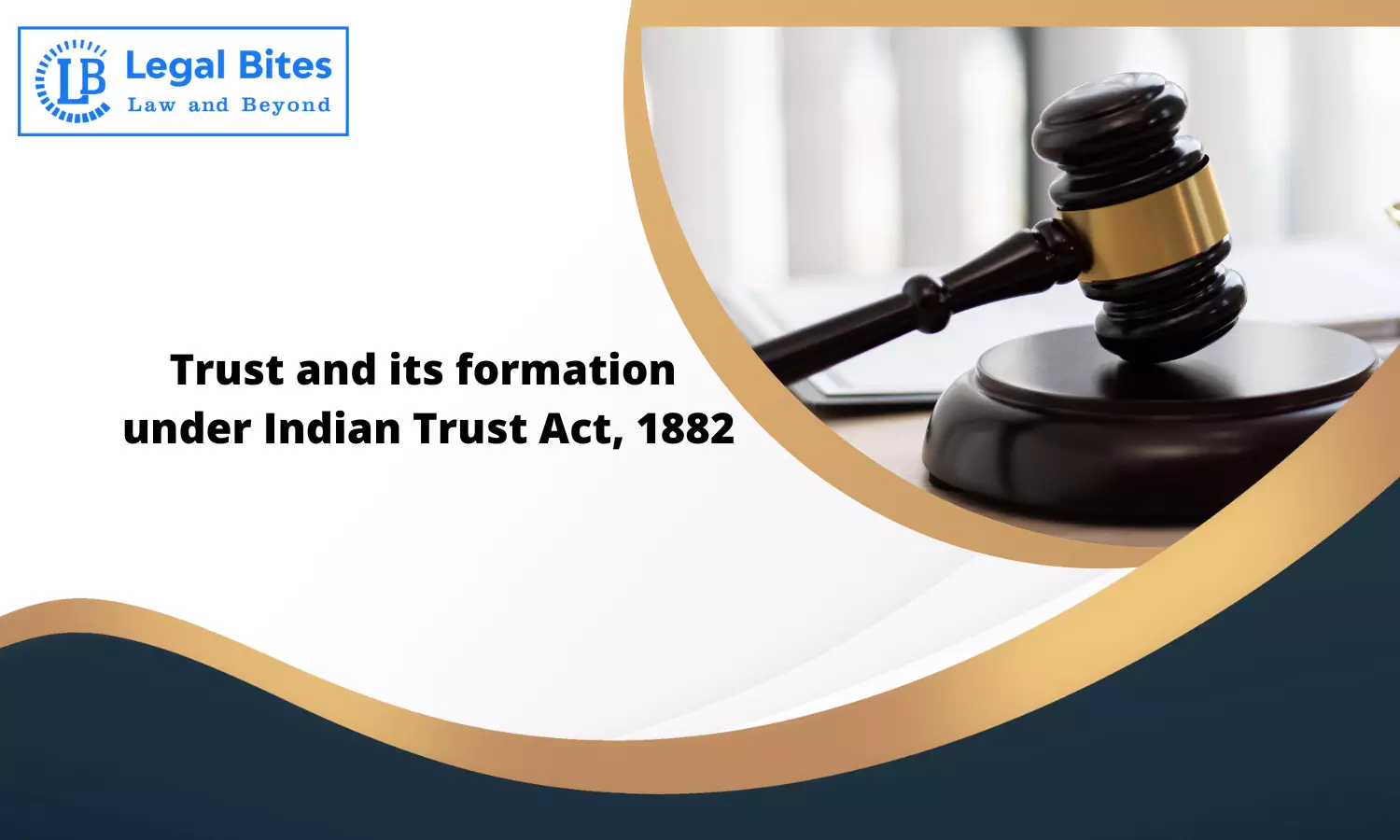Trust and its formation under Indian Trust Act, 1882
Learn how to create trusts under the Indian Trust Act, 1882. A comprehensive study on trust formation.

The article 'Trust and its formation under Indian Trust Act, 1882' is a thorough study of the creation of a trust under the Indian Trust Act. The establishment and upkeep of private trusts in India are governed by the Indian Trust Act, 1882. When a person transfers his property to another person for a third party's benefit, a trust is established. Three parties are involved in the transaction: the author, who transfers the property; (ii) the trustee, who takes care of the property; and (iii) the beneficiary, who gets the income from the trusts.
Introduction
A trust is defined as an obligation that is attached to property ownership and results from a confidence reposed and accepted by the owner for the benefit of another person and owner under the Indian Trusts Act of 1882. It is the acceptance of a commitment by someone to use or hold any sort of asset—such as money or property—in order to benefit the person for whom the trust was established. Given that there are numerous distinct types of trusts, the beneficiary's rights and obligations are also somewhat based on the type of trust.
A trust can be thought of as a three-party fiduciary arrangement, to put it simply. In this, the first party (the trust's author) typically transfers property—often money, though not always—to the second party (the trustee) for the third party's advantage (the beneficiary). The actual owner of the property is referred to as a trustee. The beneficiary(s) in this case is referred to as the property's equitable owner(s). Consequently, trustees have a responsibility to operate the trust in the best interests of the equitable owners. Equitable owners must also receive a regular accounting of trust revenue and expenses, and trustees have the right to reimbursement or compensation for any expenses they incur.
Prudence, loyalty, and impartiality are only a few of the trustee's fundamental obligations. To ensure that they behave in a way that serves the interests of the trust, a trustee may occasionally be subject to a very high level of care in their dealings. In addition to these duties, trustees are also responsible for a variety of ancillary obligations, such as making sure beneficiaries pay their obligations, etc.
The terms and conditions of the applicable law are also expected to be understood, known, and followed by a trustee at all times, in addition to the terms of the trust. The terms and conditions under which trusts are created are often what control them.
How do trusts work?
According to the Indian Trust Act of 1882, a trust is a legal structure in which the property's owner (the trustor) transfers ownership to another party (the trustee) for the benefit of a third party (beneficiary). A declaration that the trustee should hold the asset for the trust's beneficiaries is included in the transfer of such a property from the trustor to the trustee.
Objectives of Trust
The trust should be established for a legitimate purpose, according to the main goal. For instance, the trust would be null and void if Mr X had stolen money from a bank and given it to Mr Y with the aim of delivering the money to underprivileged children. So how can we truly determine whether the goal is legal or illegal? Section 4 of the Act contains the solution. According to Section 4, all purposes are considered to be legal unless they:
- are prohibited by law.
- defeat the requirements of the law.
- are dishonest.
- involve harming another person or his property Is immoral or contrary to the law.
Regulatory Framework for Trust
Indian Trusts Act of 1882 governs trusts in the country. To regulate these non-profit organisations in their own state, each state might create its own Trusts Act.
- A Trust can also support projects and receive funding, much like a Society. However, it can be difficult to secure funding or projects right away when a trust is created.
- A Trust must therefore meet specific eligibility requirements in order to receive funding or purchase projects. These standards might include things like pertinent experience, a Trust's performance, its age, and other factors.
- A Public Charitable Trust must also be registered with the charity commissioner's office, as they have jurisdiction over the Trust. Consequently, the process for registering it is as follows.
Goals of Trusts
Any legitimate reason may be used to establish trust. It is a useful tool for tax planning as well as for asset protection and resource management. Additionally, it can be set up for succession planning, privacy, spendthrift protection, and corporate structuring. Trusts are typically established or founded to achieve one or more of the following goals:
1. To satisfy the charitable and/or religious sentiments of the trust's creator in a way that protects the general welfare;
2. To claim revenue used for charitable or religious purposes is excluded from income tax under Sections 10 or 11, as applicable;
3. For the well-being of family members and/or other relatives who depend on the trust's settlor;
4. To ensure adequate property management and upkeep;
5. To control the operations of any other fund established by a person for the benefit of their employees, including provident funds, superannuation funds, gratuity funds, and others.
Who may establish trust?
Any competent person, defined as a person who is over 18 and mentally sound, may establish a trust for any legal purpose (s). The age of majority is 21, however, in the event of a juvenile for whom a guardian has been appointed by the court or whose property the superintendence has been assumed by the court of wards. A major civil court of original jurisdiction may provide approval for a minor to establish a trust for themselves or on their behalf. A trust can also be established by an organisation, firm, society, or group of people other than a human.
Requirements of establishing a Trust:
Among the requirements for establishing a trust are:
1. Author's express declaration.
2. The desire to build trust.
3. The trust's goals.
4. The trustee's name.
5. Trust assets.
6. The recipients.
7. Giving trustees access to trust assets.
Rights of a Trust Beneficiary
The revenues and earnings of the trust property belong to the beneficiary unless the trust instrument states a different intention. Again, the beneficiary has the right to demand that the trust's author precisely carry out his or her intent to the extent of the beneficiary's interest therein. A beneficiary may require the trustee to carry out a specific task on their behalf or may prevent the trustee from breaking a trust that is anticipated or likely to occur. The beneficiary may initiate a lawsuit for the execution of the trust if no trustees are appointed, all the trustees die, renounce, or are discharged, or if, for any other reason, the trustee's ability to carry out the trust becomes impractical. In this situation, the trust is carried out by the court until a trustee is chosen.
Trusts can thus be divided into two groups:
Public Trust
It is a trust, and the general public is one of its beneficiaries. A public trust can be divided into a public charitable trust and a public religious trust, among other subgroups.
Establishing a Public Trust
According to the 1908 Act, all public trusts, regardless of the state in which they are established, must be registered.
Levying fees on public trust
According to Section 11 of the 1961 Act, public trusts with religious or charitable purposes are excluded from paying taxes on their income as long as they have registered in Form 10A, the 1961 Act's form for registering trusts.
The definition of "charitable purpose" in Section 2 (15) of the 1961 Act includes the advancement of any other general public utility object, as well as the relief of the poor, education, yoga, medical assistance, environmental preservation (including watersheds, forests, and wildlife), preservation of monuments or places or objects of artistic or historic interest, and preservation of the environment.
Private Trust
A private trust is one that has families or specific persons as beneficiaries. A Private Trust may also be divided into:
- Private Trusts with known beneficiaries and the required number of shares.
- Private Trusts whose required shares and either or both beneficiaries cannot be identified.
Enrolment of a Private Trust
A private trust related to immovable property must be registered under the Registration Act of 1908 in accordance with the conditions of the 1882 Act ("1908 Act"). It is not required to register a private trust in relation to movable property.
Private Trust Taxation
The Income Tax Act, 1961 ("1961 Act"), Sections 160 to 164, lays out the taxation system in India for trusts. The trustee of a trust is recognised as the trust's representative for tax purposes by Section 160(1)(iv) of the 1961 Act. A trustee may be taxed in a representative capacity "in like way and to the same degree the beneficiaries would have to pay tax," according to Section 161(1) of the 1961 Act. In accordance with Section 161(1A), the trust may be subject to taxation at the highest marginal rate if its income comprises business earnings. According to Section 164 of the 1961 Act, the trust must be taxed at the highest marginal rate if the beneficiaries cannot be identified and their share of income cannot be determined.
Dissolving a Trust
The following situations result in a trust being dissolved:
- The goal is achieved.
- The goal is no longer legal.
- When trust property is destroyed, for instance, the goal cannot be achieved.
- If a trust is revocable, it is revoked.
- All beneficiaries who are able to enter into contracts may agree to change the intent of the trust.
Conclusion
In conclusion, we can state that the beneficiary has a number of rights under the terms of the Trusts Act and is equally responsible for any violations. The beneficiary's rights and obligations are distributed equally. This research also demonstrates that the beneficiary must continue to work well with the trust's trustees in order to protect himself from any trust violations.
Last but not least, despite the fact that a trust is primarily established for the benefit of the beneficiary, the beneficiary will still possess certain rights and obligations and must act and behave in a certain way in accordance with the Trust's restrictions.
References
[1] Medha Srivastava and Akshit Kapoor, Available Here
[2] Indian Trusts Act, 1882, Available Here
[3] Purpose & Creation of a Trust Under Indian Trusts Act, 1882, Available Here
[4] Trust under Indian Trust Act, 1882, Available Here
Important Links
Law Library: Notes and Study Material for LLB, LLM, Judiciary, and Entrance Exams

